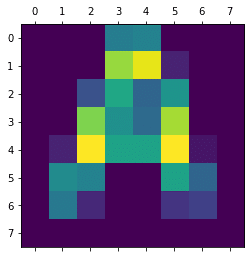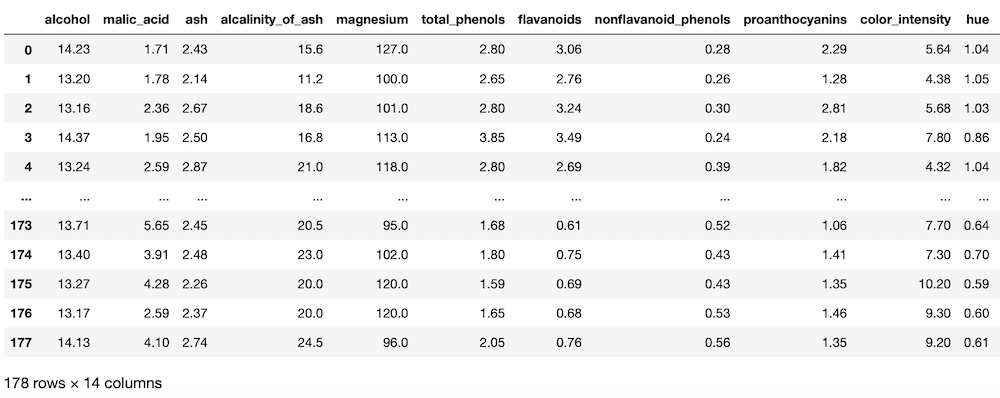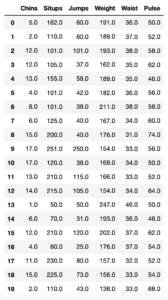機械学習ライブラリScikit-learn
前回まで機械学習ライブラリScikit-learnの手書き数字のデータセットを使って、色々な機械学習モデルを試してきました。

Scikit-learnにはあと3つデータセットがあるのですが、これまで結構色々な事をやってきたので、そろそろもっと実践的なデータセットに移りたい。。。そんな思いが芽生えてきました。
ということで残り3つのデータセットに関しては、紹介だけということにしたいと思います。
そしてまた後ほど必要があれば、随時詳細を解説していくことにしましょう。
今回は3つのデータセットのうち「ワインの分類」のデータセットを紹介していきます。
このデータセットはワイン中に含まれる成分から、どんな種類のワインかを分類するというデータセットになります。
ではでは進めていきましょう。
データセットの読み込み
まずはデータセットを読み込んでいきます。
手間を省くため、オプションを「as_Frame = True」としてPandasのデータセット形式で読み込みましょう。
<セル1>
from sklearn.datasets import load_wine
wine = load_wine(as_frame=True)
print(wine.keys())
実行結果
dict_keys(['data', 'target', 'frame', 'target_names', 'DESCR', 'feature_names'])次にデータフレームを表示してみます。
<セル2>
wine.frame
実行結果
これで読み込みが完了しました。
データセットの概要を確認
次にデータセットの概要を確認してみましょう。
<セル3>
print(wine.DESCR)
実行結果
.. _wine_dataset:
Wine recognition dataset
------------------------
**Data Set Characteristics:**
:Number of Instances: 178 (50 in each of three classes)
:Number of Attributes: 13 numeric, predictive attributes and the class
:Attribute Information:
- Alcohol
- Malic acid
- Ash
- Alcalinity of ash
- Magnesium
- Total phenols
- Flavanoids
- Nonflavanoid phenols
- Proanthocyanins
- Color intensity
- Hue
- OD280/OD315 of diluted wines
- Proline
- class:
- class_0
- class_1
- class_2
:Summary Statistics:
============================= ==== ===== ======= =====
Min Max Mean SD
============================= ==== ===== ======= =====
Alcohol: 11.0 14.8 13.0 0.8
Malic Acid: 0.74 5.80 2.34 1.12
Ash: 1.36 3.23 2.36 0.27
Alcalinity of Ash: 10.6 30.0 19.5 3.3
Magnesium: 70.0 162.0 99.7 14.3
Total Phenols: 0.98 3.88 2.29 0.63
Flavanoids: 0.34 5.08 2.03 1.00
Nonflavanoid Phenols: 0.13 0.66 0.36 0.12
Proanthocyanins: 0.41 3.58 1.59 0.57
Colour Intensity: 1.3 13.0 5.1 2.3
Hue: 0.48 1.71 0.96 0.23
OD280/OD315 of diluted wines: 1.27 4.00 2.61 0.71
Proline: 278 1680 746 315
============================= ==== ===== ======= =====
:Missing Attribute Values: None
:Class Distribution: class_0 (59), class_1 (71), class_2 (48)
:Creator: R.A. Fisher
:Donor: Michael Marshall (MARSHALL%PLU@io.arc.nasa.gov)
:Date: July, 1988
(以下略)Alcohol:アルコール濃度
Malic acid:リンゴ酸濃度
Ash:灰分濃度
Alcalinity of ash:灰のアルカリ性
Magnesium:マグネシウム量
Total phenol:フェノール量
Flavanoids:フラバノイド量
Nonflavanoid phenols:非フラバノイドフェノール類の量
Proanthocyanins:プロアントシアニン
Color intensity:色の強度
Hue:色調
OD280/OD315 of diluted wines:薄めたワインの280nmと315nmの波長の光に対する濁度
Proline:プロリン量
これらの値から「Class1」、「Class2」、「Class3」のカテゴリに分類します。
しかしワインには色々な成分がふくまれているのですね。
こういった普段考えていないような情報に当たれるのも、機械学習を学ぶいい点だと思います。
LinearSVCで機械学習してみる
このデータセットは「分類」をするデータセットなので、手書き数字のデータセットの時に使った「LinearSVC」 モデルを使って機械学習してみましょう。
<セル4>
from sklearn.svm import LinearSVC
from sklearn.model_selection import train_test_split
from sklearn.metrics import accuracy_score
x = wine.frame.iloc[:, 0:-1]
y = wine.frame.iloc[:, -1]
x_train, x_test, y_train, y_test = train_test_split(x, y, test_size=0.2, train_size=0.8)
model = LinearSVC()
model.fit(x_train, y_train)
pred = model.predict(x_test)
print(accuracy_score(y_test, pred))
実行結果
0.9166666666666666
/opt/anaconda3/lib/python3.7/site-packages/sklearn/svm/_base.py:977: ConvergenceWarning: Liblinear failed to converge, increase the number of iterations.
"the number of iterations.", ConvergenceWarning)警告が出てしまいました。
「increase the number of iterations」、つまり「繰り返し回数を増やしてくれ」ということなので、「max_iter」のオプションをつけて試してみましょう。
<セル4 修正>
from sklearn.svm import LinearSVC
from sklearn.model_selection import train_test_split
from sklearn.metrics import accuracy_score
x = wine.frame.iloc[:, 0:-1]
y = wine.frame.iloc[:, -1]
x_train, x_test, y_train, y_test = train_test_split(x, y, test_size=0.2, train_size=0.8)
model = LinearSVC(max_iter = 100000000)
model.fit(x_train, y_train)
pred = model.predict(x_test)
print(accuracy_score(y_test, pred))
実行結果
0.9722222222222222「max_iter」を100000000にしたら警告が出なくなりました。
結果も「0.97222」とかなり高くてこのままでも十分そうです。
では次回は残り2つのうち、生理学的データと運動能力の関係のデータセットを紹介します。

ということで今回はこんな感じで。

コメント